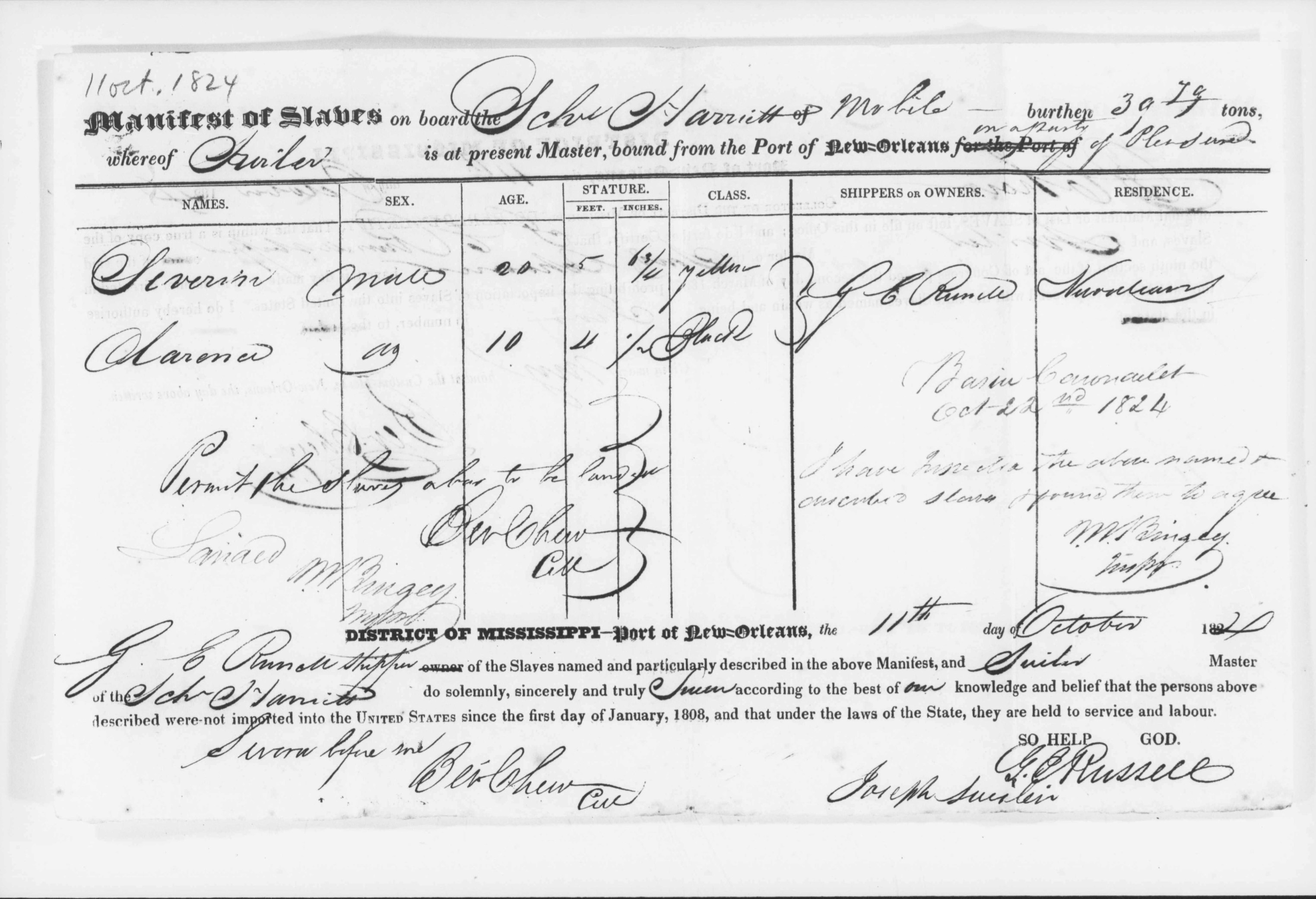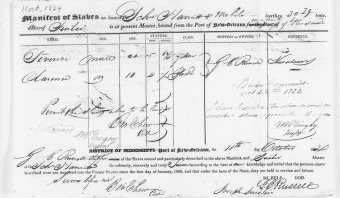
On October 11th of 1824, the schooner Harriett departed New Orleans and headed for…well…no place in particular, really.
At least this is the impression I received from the only record I’ve seen of this voyage, the heading of which reads, “Schooner Harriett of Mobile burthen 3079 tons, whereof [Joseph] Swiler is at present master, bound from the Port of New Orleans for the port of on a party of pleasure.” In the 19th century, the phrase “party of pleasure” referred to a trip taken for amusement’s sake, not unlike a modern-day cruise.[1]
Party of pleasure.
The phrase was charming, or at least, it would have been, had I encountered it somewhere else. Here, however, it was scrawled across the top of a document listing the names and physical descriptions of the two enslaved people who—in addition to white passengers—were aboard the Harriett for its voyage to nowhere. Rather than conjuring scenes of rum-drunk joviality, then, the phrase underscored the ways white Southerners extracted wealth and its extravagances from the lives and labors of unfree Black people in antebellum America.
The two captives aboard the Harriett were named “Severin” (20 years old and 5 feet 6¾ inches tall) and “Clarence” (10 years old and just over 4 feet in stature). On the manifest, both were identified as the legal “property” of G.E. Russell, likely a passenger on the ship. Russell, whose full name was Gilbert E. Russell, was a local merchant with a shop on Canal Street just below Royal Street, where the French Quarter blends into Downtown New Orleans.[2]
The Harriett’s manifest and thousands like it were mandated by the 1807 “Act Prohibiting Importation of Slaves,” which both outlawed the nation’s participation in the transatlantic slave trade and required any captain of a coastwise vessel with enslaved people onboard to file a manifest, at both the port of departure and of the port of arrival, listing the captives by name and description and swearing that they had not been illegally trafficked from Africa after the ban.
Over the past several years, I have examined, at current count, more than 8,000 of these records. Until now, however, I have primarily focused on the subset within them documenting the traffic of enslaved people to New Orleans, but I am now in the process of incorporating manifests drafted for voyages to and from close to 100 domestic ports stretching as far north as Boston, Massachusetts, as far south as Key West, Florida, and as far west as Port Lavaca, Texas.
Like the data recently added to Oceans of Kinfolk by a team of researchers at Rice University, the records I am now examining reveal that the coastwise traffic was far more complicated than I previously understood. While the forced migrations of enslaved people (as a result of both the interregional trade in human beings and the southwestern migration of slaveholders) clearly accounted for the bulk of the coastwise traffic, enslaved people’s names appeared on manifests for a variety of reasons. So, for most, the voyage experience represented a moment of rupture and uprooting, but for others, travel by sea was likely a disruptive but familiar aspect of life in bondage. Many enslaved people were sent back and forth between their enslavers’ multiple plantations. Others were put to work building canals and other public works on behalf of state governments, first in one place and then another. Still others were hired out by their enslavers over vast distances, and then sent back at the completion of the contract. And some, like Severin and Clarence, found themselves at sea for no other reason than that their enslaver found “pleasure” there.
In short, the coastwise traffic encompassed a multitude of experiences and scenarios: complexity which will soon be reflected in the Oceans of Kinfolk database, and which I plan to fully explore in my upcoming book, to be published by the University of North Carolina Press next year.
Jennie K. Williams is a postdoctoral fellow at the University of Virginia.
The post “American Slavery at Sea” first appeared in Echoes: The SlaveVoyages Blog. It is part of a series of posts exploring the history and legacies of the slave trade to Texas.
Notes:
[1] Manifest of the Harriett of Mobile, October 11, 1824; New Orleans Outward Manifests, 1824-1827, National Archives and Records Administration (NAID 173903848).
[2] I have found no other records related to Clarence. Severin, however, appears in the inventory taken of Gilbert Russell’s estate in 1830. He is described as being a “waiter” and 26 years old. Estate of Gilbert E. Russell, 24 December,1830, Probate Court of Orleans Parish.
